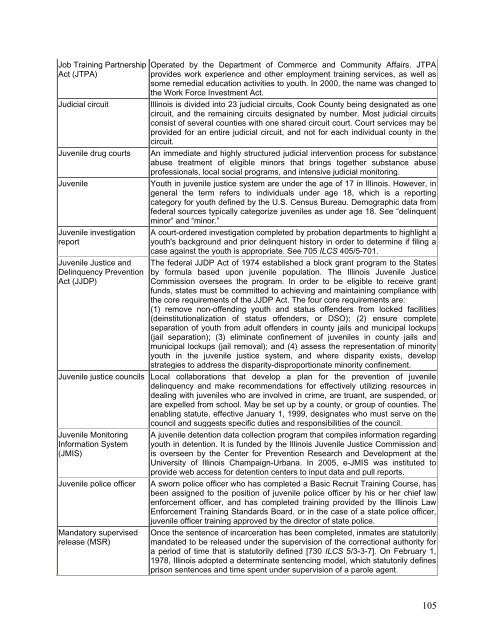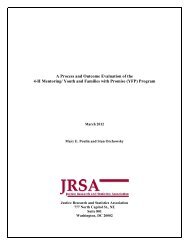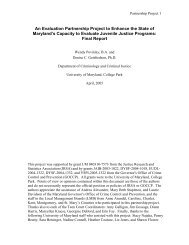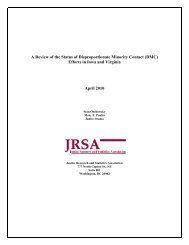Juvenile Justice System and Risk Factor Data - Illinois Criminal ...
Juvenile Justice System and Risk Factor Data - Illinois Criminal ...
Juvenile Justice System and Risk Factor Data - Illinois Criminal ...
You also want an ePaper? Increase the reach of your titles
YUMPU automatically turns print PDFs into web optimized ePapers that Google loves.
Job Training Partnership<br />
Act (JTPA)<br />
Judicial circuit<br />
<strong>Juvenile</strong> drug courts<br />
<strong>Juvenile</strong><br />
<strong>Juvenile</strong> investigation<br />
report<br />
<strong>Juvenile</strong> <strong>Justice</strong> <strong>and</strong><br />
Delinquency Prevention<br />
Act (JJDP)<br />
Operated by the Department of Commerce <strong>and</strong> Community Affairs. JTPA<br />
provides work experience <strong>and</strong> other employment training services, as well as<br />
some remedial education activities to youth. In 2000, the name was changed to<br />
the Work Force Investment Act.<br />
<strong>Illinois</strong> is divided into 23 judicial circuits, Cook County being designated as one<br />
circuit, <strong>and</strong> the remaining circuits designated by number. Most judicial circuits<br />
consist of several counties with one shared circuit court. Court services may be<br />
provided for an entire judicial circuit, <strong>and</strong> not for each individual county in the<br />
circuit.<br />
An immediate <strong>and</strong> highly structured judicial intervention process for substance<br />
abuse treatment of eligible minors that brings together substance abuse<br />
professionals, local social programs, <strong>and</strong> intensive judicial monitoring.<br />
Youth in juvenile justice system are under the age of 17 in <strong>Illinois</strong>. However, in<br />
general the term refers to individuals under age 18, which is a reporting<br />
category for youth defined by the U.S. Census Bureau. Demographic data from<br />
federal sources typically categorize juveniles as under age 18. See “delinquent<br />
minor” <strong>and</strong> “minor.”<br />
A court-ordered investigation completed by probation departments to highlight a<br />
youth's background <strong>and</strong> prior delinquent history in order to determine if filing a<br />
case against the youth is appropriate. See 705 ILCS 405/5-701.<br />
The federal JJDP Act of 1974 established a block grant program to the States<br />
by formula based upon juvenile population. The <strong>Illinois</strong> <strong>Juvenile</strong> <strong>Justice</strong><br />
Commission oversees the program. In order to be eligible to receive grant<br />
funds, states must be committed to achieving <strong>and</strong> maintaining compliance with<br />
the core requirements of the JJDP Act. The four core requirements are:<br />
(1) remove non-offending youth <strong>and</strong> status offenders from locked facilities<br />
(deinstitutionalization of status offenders, or DSO); (2) ensure complete<br />
separation of youth from adult offenders in county jails <strong>and</strong> municipal lockups<br />
(jail separation); (3) eliminate confinement of juveniles in county jails <strong>and</strong><br />
municipal lockups (jail removal); <strong>and</strong> (4) assess the representation of minority<br />
youth in the juvenile justice system, <strong>and</strong> where disparity exists, develop<br />
strategies to address the disparity-disproportionate minority confinement.<br />
<strong>Juvenile</strong> justice councils Local collaborations that develop a plan for the prevention of juvenile<br />
delinquency <strong>and</strong> make recommendations for effectively utilizing resources in<br />
dealing with juveniles who are involved in crime, are truant, are suspended, or<br />
are expelled from school. May be set up by a county, or group of counties. The<br />
enabling statute, effective January 1, 1999, designates who must serve on the<br />
council <strong>and</strong> suggests specific duties <strong>and</strong> responsibilities of the council.<br />
<strong>Juvenile</strong> Monitoring<br />
Information <strong>System</strong><br />
(JMIS)<br />
<strong>Juvenile</strong> police officer<br />
M<strong>and</strong>atory supervised<br />
release (MSR)<br />
A juvenile detention data collection program that compiles information regarding<br />
youth in detention. It is funded by the <strong>Illinois</strong> <strong>Juvenile</strong> <strong>Justice</strong> Commission <strong>and</strong><br />
is overseen by the Center for Prevention Research <strong>and</strong> Development at the<br />
University of <strong>Illinois</strong> Champaign-Urbana. In 2005, e-JMIS was instituted to<br />
provide web access for detention centers to input data <strong>and</strong> pull reports.<br />
A sworn police officer who has completed a Basic Recruit Training Course, has<br />
been assigned to the position of juvenile police officer by his or her chief law<br />
enforcement officer, <strong>and</strong> has completed training provided by the <strong>Illinois</strong> Law<br />
Enforcement Training St<strong>and</strong>ards Board, or in the case of a state police officer,<br />
juvenile officer training approved by the director of state police.<br />
Once the sentence of incarceration has been completed, inmates are statutorily<br />
m<strong>and</strong>ated to be released under the supervision of the correctional authority for<br />
a period of time that is statutorily defined [730 ILCS 5/3-3-7]. On February 1,<br />
1978, <strong>Illinois</strong> adopted a determinate sentencing model, which statutorily defines<br />
prison sentences <strong>and</strong> time spent under supervision of a parole agent.<br />
105

















